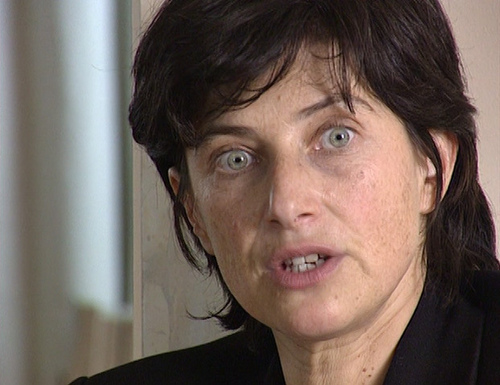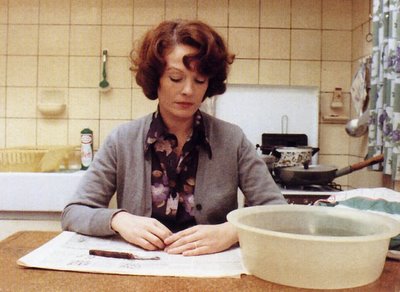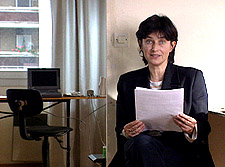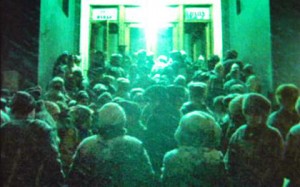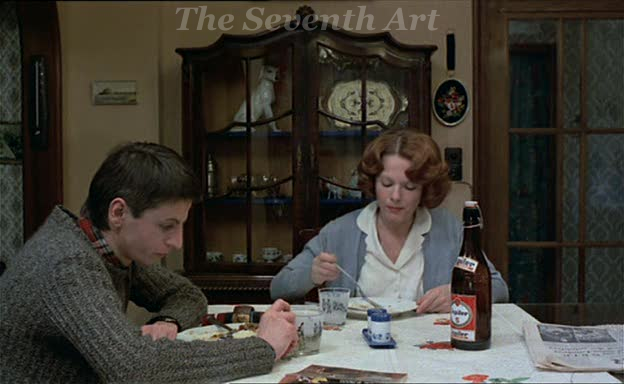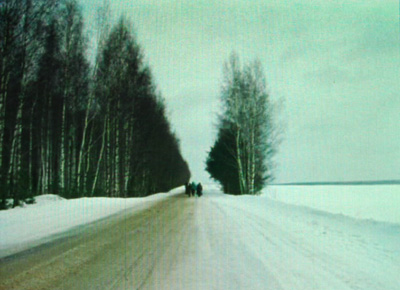From the Chicago Reader (October 24, 1997). — J.R.
Chantal Akerman by Chantal Akerman
Rating *** A must see
Directed and written by Chantal Akerman.
This weekend the Museum of Contemporary Art, as part of its exhibit “Hall of Mirrors: Art and Film Since 1945,” is presenting not only Chantal Akerman, one of the finest filmmakers working anywhere, but also the two features I would describe as her greatest achievements — the 200-minute narrative Jeanne Dielman, 23 quai du Commerce, 1080 Bruxelles (1975) and the 107-minute documentary From the East (D’est, 1993). To make the program even more fully rounded, the museum is also showing a 64-minute self-portrait, Chantal Akerman by Chantal Akerman (1996), which provides an excellent introduction to her work as a whole. (This film and Akerman herself will appear on Sunday; From the East shows on Friday, and Jeanne Dielman on Saturday.)
Despite her significant and still growing international reputation, Akerman isn’t yet considered an “established” mainstream or avant-garde artist, because many critics in both spheres still treat her as something of an interloper, even an irritation or a threat. A friend who’s a highly respected novelist and film critic recently told me that he regards all her work as worthless, even though he hasn’t bothered to look at all of it. Among the better-known gatekeepers of avant-garde film in New York, one woman dismissed Jeanne Dielman outright when it belatedly straggled into the city in the late 70s, while one man half-seriously avowed in private that he couldn’t possibly accept an epic about women’s housework that shows someone making Wiener schnitzel incorrectly.
What all three were reacting against, I suspect, is what Akerman chooses to film and finds interesting — the kind of choices that define what most innovative representational art consists of. Generally speaking, her turf is the sort of everyday life that’s excluded from most other pictures, and in my experience, gatekeeper critics tend to have more trouble with this turf than most audiences. When From the East was screened for the press at the Toronto film festival four years ago only five people stayed to the end, but at the public screenings I attended in Toronto and Locarno few people walked out.
I suspect mainstream critics walk out because they invest so many hours persuading themselves that most commercial movies are worth sitting through that they tend to resent movies whose very premises make most commercial movies — and the hype they routinely provoke — seem foolish. And I suspect some avant-garde film critics resent Akerman’s steadfast refusal to confine her work to the avant-garde and experimental realm — instead moving freely between narrative and nonnarrative, relatively independent and relatively industrial forms of filmmaking.
Chantal Akerman by Chantal Akerman — made for the venerable French TV series “Cinema of Our Time” (originally called “Filmmakers of Our Time,” it stretches back to the 60s) — opens with a long shot of a simply furnished officelike room. A dog enters the frame from the foreground, eventually sitting down on the floor at the left while Akerman emerges from around a corner and seats herself on the right, facing the camera and proceeding to explain how she came to make this film. Some of what she says is extemporaneous, some is read from a text. She explains that she will treat her previous films as rushes and that the producers, Janine Bazin and Andre Labarthe, insisted that she appear in the film, occasioning this introduction.
After going into some detail concerning her blocked feelings about this project and recounting a Jewish joke about a man trying to sell an undernourished cow by way of a metaphor, she talks briefly about being born in Brussels in 1950, the daughter of Polish Jews who settled there in the 30s. She explains that when she started to make films at the age of 18 no one in her family encouraged her or thought that the facts of their own lives were worth making films about.
Then Akerman speaks about her grandmother, who did huge paintings, none of which seems to have survived (and which she knows about only through her mother), and reflects a little on the implications of this for her own work — citing the Second Commandment and Jewish taboos against visual representation, especially art produced by and about women. (The size of her grandmother’s paintings and the fact that they showed women who appeared to be looking out at the viewer are suggestive of the monumentality of Akerman’s work as well as its aggressive modes of address.) After this comes the title “Self Portrait,” followed by fleeting titles that catalog the 15 films she’ll be showing excerpts of and the 13 other films that won’t be represented.
By my count, the remainder of the film, apart from a few closing words by Akerman, consists of 34 clips, and the three films excerpted most often are From the East (five clips), Jeanne Dielman (four), and the 1993 Portrait of a Young Girl in Brussels (four). This is an accurate representation of her work at its best, though I regret the absence of two favorites, the 1983 The Man With a Suitcase and the 1991 Night and Day, both of which I seem to like more than most Akerman fans. These clips aren’t shown chronologically, and extracts from some of the films recur, but the logic of the juxtapositions is almost always easy to follow.
Sometimes the links are thematic, as in a cut from Jeanne Dielman (Delphine Seyrig) polishing her son’s black shoes in the kitchen to Akerman, starring at 18 in her first film (Saute ma ville, 1968), polishing her own black shoes in her own kitchen. But the formal and temperamental differences between these segments are just as important as the thematic linkages: Saute ma ville, shot in nonsynchronous sound and black and white, is in many ways a primitive sketch for Jeanne Dielman, shot in sync sound and color; and the giddy abandon with which Akerman polishes her own shoes while she’s wearing them — and records the sounds of polishing so that they fail to match her own contorted, jerky movements — provides a stark contrast with the highly controlled and coordinated moves of Seyrig (and Akerman the filmmaker). The difference isn’t necessarily between crude technique and polished technique, for in documentary films such as News From Home and From the East Akerman uses nonsynchronous sound in ways that are both subtle and complex.
Later cutting boldly from a Pina Bausch dance performance in One Day Pina Asked Me (1983) to a tracking shot past pedestrians standing in the snow at a Moscow bus stop in From the East, Akerman is able to show a formal relationship between the filming of figures in a landscape in two radically different TV documentaries. Prior to that she demonstrates numerous relationships, moving from the music rehearsals of Les annees 80 (1983), her feature-length “trailer” for a full-scale musical, to a fully realized scene from the musical itself (Golden Eighties, aka Window Shopping, 1985), to a series of dance rehearsals in Les annees 80s, then to another Bausch performance in One Day Pina Asked Me. Here we see Akerman joyfully conducting a singer in a recording studio, visibly even more taken by the music than the singer, and her grandiloquent gestures are much closer to dance than the swaying of the background figures in the finally realized number; similarly, the dissolving pirouettes of various dancers in a rehearsal for the same film have more life than the “finished” performance by Bausch’s troupe that we glimpse just afterward. (The most exuberant dancing of all comes just before, in an extended sequence from Portrait of a Young Girl in Brussels.)

Akerman appears in almost a third of the films excerpted here — more if one adds a couple in which we hear her offscreen voice — and one of the fascinations of this critical and selective tour is watching her own gestures being reproduced in other films by some of her actresses. (Aurore Clement nibbling food off a stray hotel tray on a hallway floor in the autobiographical Les rendez-vous d’Anna from 1978 comes just after we see Akerman compulsively devouring sugar from a spoon in the 1974 Je tu il elle.) But Akerman’s disarming tactic of using herself as a star — which she criticizes in her introduction as a dubious form of bravado — and some of her stars as versions of herself has to be weighed against her determination to film anonymous, everyday people as if they were just as important and her determination to integrate stars and nobodies in films such as American Stories (1988). The sorrow and beauty throughout her work, with its shining nocturnal moods and glowering compulsive activities, has a lot to do with exalting the unexceptional, the neglected corners of the world around us.

